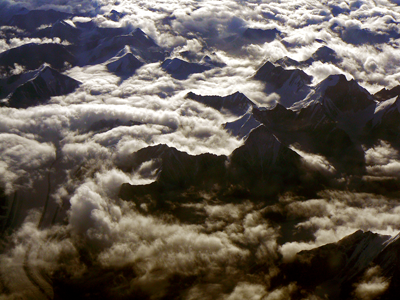Earth Chemistry
Click on the links below to read the 2006 Earth Chemistry research highlights Or download the 2006 Earth Chemistry Research Highlights in PDF format HERE
882 Kb
Introduction
The chemistry and isotope chemistry of natural materials is highly indicative of provenance and process throughout geological history. Our studies range in time from the earliest solar system through to processes that are actively taking place today, and in scope from planetary systems to individual molecules.
Most of our analytical work involves detailed analysis on the microscale, or concentrating trace elements from larger samples for high precision analysis. Isotopic systems can reveal both the nature of the processes involved (stable isotopes) as well as the timing of events (radiogenic isotopes), while chemical abundances can reflect protolith contributions and processes affecting various systems including biologic systems. As revealed in this year's research contributions, analytical work can be applied to topics in tectonics, ore genesis, metamorphic petrology, paleoclimate, paleoecology and regolith dating.
Geobiology
A new direction in Earth Chemistry is the study of organic matter and biomarker molecules extracted from sedimentary rocks by Dr Jochen Brocks. Biomarkers give information about ancient microbial ecosystems and their environments. Earth Chemistry and RSES have committed to a new laboratory facility for biomarker research including a new mass spectrometer. We were able to secure central support for the construction of a new laboratory and construction started on 21 November and will be completed by end-February 2007.
SHRIMP
This year has seen systematic improvements in our abilities to measure stable isotope ratios with SHRIMP II in negative ion mode. A combination of terrestrial-magnetic-field suppression, mount redesign, and suppression of secondary ions induced by the electron gun, had all contributed to pulling analytical errors well into the subpermil range. SHRIMP I has had a computer refit, even though the 14-year-old Apple Mac II has performed flawlessly, and a stage drive upgrade such that stage positions can be computer controlled. This allows unattended computer-controlled analyses. SHRIMP SI progresses with the ordering of many of the major components and final designs for most assemblies being carried out or completed.
Personnel
This year we welcome APF Fellow Dr Ian Buick who has moved from Monash University to continue his studies in combinations of metamorphic petrology, conventional light isotope geochemistry of carbonates (O-C) and silicate (O) rocks, U-Pb geochronology and mineral-scale trace element geochemistry.
Dr Yuri Amelin of the Canadian Geological Survey, Ottawa , has accepted a position funded by the Planetary Science Institute and is expected to arrive in early 2007. Dr Amelin's specialty is high precision geochronology, focusing on the earliest chronology of the solar system.ARC and MEC
This year saw one ARC Discovery awarded to Dr Jochen Brocks for research into saline Lake Tyrrell mud. Further in this research, an ANU / U.C. Berkeley / Macquarie University collaboration in the Lake Tyrrell Metagenome/Biomarker project was successful with the award of US$1,920,911 from NSF to our collaborator Prof Jill Banfield (UC Berkeley) for the genome sequencing part of the project. Dr Masahiko Honda and collaborators were successful in securing ARC and MEC funding for a multicollector noble gas mass spectrometer, and Dr Jochen Brocks received MEC funding for an automated solvent extraction system.Research Highlights
